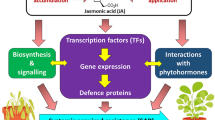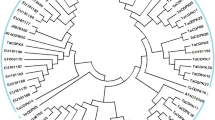Abstract
The full-length pathogen-inducible plant defensin gene encoding 80 amino acid sequences of pathogen-related gene PR12 (Bjdefensin) was isolated from Brassica juncea. Conserved domain (CD) search reveals its similarity with gamma thionin and knottins families of plant antimicrobial peptides. The protein blast reveals more than 80% of its similarity with defensin-like protein of Brassica rapa and Camelina sativa. Gene expression studies revealed that the transcript levels of Bjdefensin gene increases significantly upon Alternaria infection, jasmonic acid and wounding treatments but was not induced by salicylic acid. To further study the stress-inducible regulation of Bjdefensin gene, its promoter (2.5 kb) was isolated and cloned upstream of GUS gene in pORER2 vector. In silico studies of Bjdefensin promoter showed many important conserved cis-elements, responsive to biotic and abiotic stresses. Histochemical GUS assay showed pathogen-inducible expression of Bjdefensin promoter after fungal infection. Bjdefensin promoter was also induced by Jasmonic acid and wounding.









Similar content being viewed by others
Abbreviations
- SA:
-
Salicylic acid
- JA:
-
Jasmonic acid
- ET:
-
Ethylene
- SAR:
-
Systemic acquired resistance
- ISR:
-
Induced systemic resistance
References
Anuradha, T. S., Divya, K., Jami, S. K., & Kirti, P. B. (2008). Transgenic tobacco and peanut plants expressing a mustard defensin show resistance to fungal pathogens. Plant Cell Reports, 27, 1777–1786.
Anuradha, T. S., Jami, S. K., & Kirti, P. B. (2009). A defensin gene of indian mustard is stress induced. Journal of Plant Biochemistry and Biotechnology, 18(2), 221–224.
Beer, A. D., & Vivier, M. A. (2011). Four plant defensins from an indigenous South African Brassicaceae species display divergent activities against two test pathogens despite high sequence similarity in the encoding genes. BMC Research Notes, 4, 459.
Broekaert, W., Terras, F. R., Cammue, B. P. A., & Osborn, R. W. (1995). Plant defensins: novel antimicrobial peptides as components of the host defense system. Plant Physiology, 108(4), 1353–1358.
Carvalho, A. O., & Gomes, V. M. (2011). Plant defensins and defensin-like peptides—biological activities and biotechnological applications. Current Pharmaceutical Design, 17, 4270–4293.
Carvalho, A. O., & Gomesa, V. M. (2009). Plant defensins Prospects for the biological functions and biotechnological properties. Peptides, 30, 1007–1020.
Clough, S. J., & Bent, A. (1998). Floral dip: A simplified method for Agrobacterium-mediated transformation of Arabidopsis thaliana. Plant Journal, 16, 735–743.
Coninck, B. M. De, Sels, J., Venmans, E., Thys, W., Goderis, I. J., Carron, D., et al. (2010). Arabidopsis thaliana plant defensin AtPDF1.1 is involved in the plant response to biotic stress. New Phytologist, 187, 1075–1088.
Despres, C., Chubak, C., Rochon, A., Clark, A., Bethune, T., Desveaux, D., & Fobert, P. R. (2003). The Arabidopsis NPR1 disease resistance protein is a novel cofactor that confers redox regulation of DNA binding activity to the basic domain/leucine zipper transcription factor TGA1. Plant Cell, 15, 2181–2191.
Elliott, K. A., & Shirsat, A. H. (1998). Promoter regions of the extA extensin gene from Brassica napus control activation in response to wounding and tensile stress. Plant Molecular Biology, 37, 675–687.
Epple, P., Apel, K., & Bohlmann, H. (1997). ESTs reveal a multigene family for plant defensins in Arabidopsis thaliana. FEBS Letters, 400, 168e172.
Garcia-Olmedo, F., Molina, A., Alamillo, J. M., & Rodriguez Palenzuela, P. (1998). Plant defense peptides. Biopolymers, 47, 479–491.
Giri, P., Taj, G., & Kumar, A. (2013). Comparison of artificial inoculation methods for studying pathogenesis of Alternaria brassicae (Berk.) Sacc on Brassica juncea (L.) Czern. (Indian mustard). African Journal of Biotechnology, 12(18), 2422–2426.
Glauser, G., Grata, E., Dubugnon, L., Rudaz, S., Farmer, E. E., & Wolfender, J. L. (2008). Spatial and temporal dynamics of jasmonate synthesis and accumulation in Arabidopsis in response to wounding. Journal of Biological Chemistry, 283, 16400–16407.
Glazebrook, J. (2005). Contrasting mechanisms of defense against biotrophic and necrotrophic pathogens. Annual Review of Phytopathology, 43, 205–227.
Hanks, J. N., Snyder, A. K., Graham, M. A., Shah, R. K., Blaylock, L. A., Harrison, M. J., et al. (2005). Defensin gene family in Medicago truncatula structure, expression and induction by signal molecules. Plant Molecular Biology, 58, 385–399.
Jefferson, R. A. (1987). Assaying chimeric genes in plants: the GUS gene fusion system. Plant Molecular Biology Reporter, 5, 387–405.
Jung, C., Lyou, S. H., Yeu, S., Kim, M. A., Rhee, S., Kim, M., et al. (2007). Microarray-based screening of jasmonate-responsive genes in Arabidopsis thaliana. Plant Cell Reports, 26, 1053–1063.
Kovalchuk, N., Li, M., Wittek, F., Reid, N., Singh, R., Shirley, N., et al. (2010). Defensin promoters as potential tools for engineering disease resistance in cereal grains. Plant Biotechnology Journal, 8, 47–64.
Kumar, S., Stecher, G., & Tamura, K. (2016). MEGA7: Molecular Evolutionary Genetics Analysis version 7.0 for bigger datasets. Molecular biology and evolution. Molecular Biology and Evolution, 33(7), 1870–1874. doi:10.1093/molbev/msw054.
Lay, F. T., & Anderson, M. A. (2005). Defensins-components of the innate immune system in plants. Current Protein and Peptide Science, 6, 85–101.
Mahmoud, E. A., Solliman, M., et al. (2008). Cloning of a novel antifungal promoter from Phaseolus vulgaris and the determination of its activity in stably transformed Nicotiana tabacum plants. Current Issues in Molecular Biology, 11, 55–63.
Manners, J. M., Penninckx, I. A. M. A., Vermaere, K., Kazan, K., Brown, R. L., Morgan, A., et al. (1998). The promoter of the plant defensin gene PDF1.2 from Arabidopsis is systemically activated by fungal pathogens and responds to methyl jasmonate but not to salicylic acid. Plant Molecular Biology, 38(6), 1071–1080.
Mishra, A., Pandey, D., Goel, A., & Kumar, A. (2010). Molecular cloning and insilico analysis of functional homologues of hypersensitive response gene(s) induced during pathogenesis of Alternaria blight in two genotypes of Brassica. Journal of Proteomics and Bioinformatics, 3, 244–248.
Murray, M. G., Thompson, W. F. (1980). Rapid isolation of high molecular weight plant DNA, Vol. 8 Nucle Aci Res. Institution of Washington, Department of Plant Biology, Stanford, CA 94305, USA
Nishiuchi, T., Shinshi, H., & Suzuki, K. (2004). Rapid and transient activation of transcription of the ERF3 gene by wounding in tobacco leaves: Possible involvement of NtWRKYs and autorepression. Journal of Biological Chemistry, 279, 55355–55361.
Park, H. C., Kang, Y. H., Chun, H. J., Koo, J. C., Cheong, Y. H., Kim, C. Y., et al. (2002). Characterization of a stamen-specific cDNA encoding a novel plant defensin in Chinese cabbage. Plant Molecular Biology, 50, 59–69.
Penninckx, I. A. M. A., Eggermont, K., Terras, F. R. G., Thomma, B. P. H. J., Samblanx, G. W., Buchala, A., et al. (1996). Pathogen-induced systemic activation of a plant defensin gene in Arabidopsis follows a salicylic acid-independent pathway. Plant Cell, 8, 2309–2323.
Penninckx, I. A. M. A., Thomma, B. P. H. J., Buchala, A., Metraux, J. P., & Broekaert, W. F. (1998). Concomitant activation of jasmonate and ethylene response pathways is required for induction of a plant defensin gene in Arabidopsis. Plant Cell, 10(12), 2103–2113.
Sasaki, Y., Asamizu, E., Shibata, D., Nakamura, Y., Kaneko, T., Awai, K., et al. (2001). Monitoring of methyl jasmonate-responsive genes in Arabidopsis by cDNA macroarray: self-activation of jasmonic acid biosynthesis and crosstalk with other phytohormone signaling pathways. DNA Research, 8(4), 153–161.
Schenk, P. M., Kazan, K., Wilson, I., Anderson, J. P., Richmond, T., Somerville, S. C., et al. (2000). Coordinated plant defense responses in Arabidopsis revealed by microarray analysis. Proceedings of the National Academy of Sciences USA, 97(21), 11655–11660.
Terras, F. R. G., Eggermont, K., Kovaleva, V., Raikhel, N. V., Osborn, R. W., & Kester, A. (1995). Small cysteine-rich antifungal proteins from radish, their role in host defense. Plant Cell, 7, 573–588.
Thomma, B. P. H. J., Cammue, B. P. A., & Thevissen, K. (2002). Plant defensins. Planta, 216, 193–202.
Thomma, B. P., Eggermont, K., Penninckx, I. A., Mauch-Mani, B., Vogelsang, R., Cammue, B. P., et al. (1998). Separate jasmonate-dependent and salicylate dependent defense-response pathways in Arabidopsis are essential for resistance to distinct microbial pathogens. Proceedings of the National Academy of Sciences USA, 95, 15107–15111.
Van Loon, L. C., & Van Strien, E. A. (1999). The families of pathogenesis-related proteins, their activities, and comparative analysis of PR1 type proteins. Physiological and Molecular Plant Pathology, 55, 85–97.
Venu, V., Singh, N., Vasudev, S., Yadava, D. K., Kumar, S., Naresh, S., et al. (2013). Assesment of genetic diversity in Brassica juncea (brassicaceae) genotypes using phenotypic differences and SSR markers. Revista de biología tropical, 61(4), 1919–1934.
Vieweg, M. F., Fruhling, M., Quandt, H. J., Heim, U., Baumlein, H., Puhler, A., et al. (2004). The promoter of the Vicia faba L. leghemoglobingene VfLb29 is specifically activated in the infected cells of root nodules and in the arbuscule-containing cells ofmycorrhizal roots from different legume and nonlegume plants. Molecular Plant-Microbe Interactions, 17, 62–69.
Wang, Z., Mao, H., Dong, C., Ji, R., Cai, L., Fu, H., et al. (2009). Overexpression of Brassica napus MPK4 enhances resistance to Sclerotinia sclerotiorum in oilseed rape. MPMI, 22(3), 235–244.
Wong, J. H., Xia, L., & Ng, T. B. (2007). A review of defensins of diverse origins. Current Protein and Peptide Science, 8, 446–459.
Wu, J., Wu, L., Liu, Z., Qian, L., Wang, M., Zhou, L., et al. (2009). A plant defensin gene from Orychophragmus violaceus can improve Brassica napus’ resistance to Sclerotinia sclerotiorum. African Journal of Biotechnology, 8(22), 6101–6109.
Yevtushenko, D. P., Sidorov, V. A., Romeroa, R., Kaya, W. W., & Misra, S. (2004). Wound-inducible promoter from poplar is responsive to fungal infection in transgenic potato. Plant Science, 167, 715–772.
Zimmerli, L., Stein, M., Lipka, V., Schulze-Lefert, P., & Somerville, S. (2004). Host and non-host pathogens elicit different jasmonate/ethylene responses in Arabidopsis. Plant Journal, 40, 633–646.
Acknowledgements
Author is thankful to Director NRCPB for all possible help and financial support during the tenure of the work. This study was funded by NRCPB. The authors declare that they have no conflict of interest.
Author information
Authors and Affiliations
Corresponding author
Rights and permissions
About this article
Cite this article
Rawat, S., Ali, S., Nayankantha, N.N.C. et al. Isolation and expression analysis of defensin gene and its promoter from Brassica juncea . J Plant Dis Prot 124, 591–600 (2017). https://doi.org/10.1007/s41348-017-0103-y
Received:
Accepted:
Published:
Issue Date:
DOI: https://doi.org/10.1007/s41348-017-0103-y




